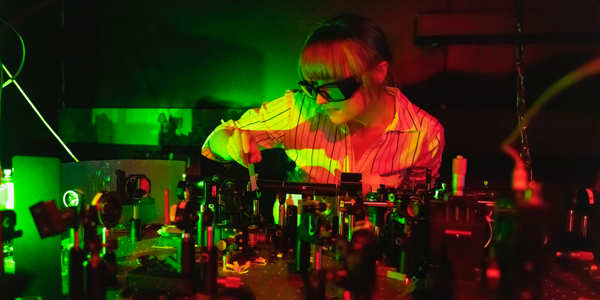Researchers Securely ‘Teleport’ Images Across a Network Using Only Light

Insider Brief
- An international team of researchers demonstrates the teleportation-like transport of “patterns” of light.
- The demonstration is reportedly first approach that can transport images across a network without physically sending the image, and a crucial step towards realizing a quantum network for high-dimensional entangled states.
- Team members included scientists from the University of the Witwatersrand, Johannesburg, and ICFO – The Institute of Photonic Sciences, Spain
- Image and Story: Wits University
PRESS RELEASE — Nature Communications published research by an international team from the University of the Witwatersrand, Johannesburg, and ICFO – The Institute of Photonic Sciences, Spain, which demonstrates the teleportation-like transport of “patterns” of light – this is the first approach that can transport images across a network without physically sending the image, and a crucial step towards realising a quantum network for high-dimensional entangled states.
Quantum communication over long distances is integral to information security and has been demonstrated with two-dimensional states (qubits) over very long distances between satellites. This may seem enough if we compare it with its classical counterpart, i.e., sending bits that can be encoded in 1s (signal) and 0s (no signal), one at a time. However, quantum optics allow us to increase the alphabet and to securely describe more complex systems in a single shot, such as a unique fingerprint or a face.
“Traditionally, two communicating parties physically send the information from one to the other, even in the quantum realm,” says Professor Andrew Forbes, the lead PI from Wits University. “Now, it is possible to teleport information so that it never physically travels across the connection – a “Star Trek” technology made real.” Unfortunately, teleportation has so far only been demonstrated with three dimensional states (imagine a three pixel image) therefore needing additional entangled photons to reach higher dimensions.
In this research, the team performed the first experimental demonstration of the quantum transport of high-dimensional states with just two entangled photons as a quantum resource, which resulted in the information appearing to be “teleported” from the sender to the receiver. To make the advance, the team used a nonlinear optical detector that circumvents the need for additional photons, yet works for any “pattern” that needs to be sent.
They report a new state-of-the-art of 15 dimensions, with the scheme scalable to even higher dimensions, paving the way for quantum network connections with high information capacity.
Practical applications in a banking setting
Imagine a customer wishing to send sensitive information to a bank – a fingerprint perhaps. In traditional quantum communication the information must be physically sent from the customer to the bank, always with the risk of interception (even if it is secure). In the newly proposed quantum transport scheme, the bank sends a single photon (one of an entangled pair) with no information to the customer, who overlaps it on a nonlinear detector with the information that is to be sent. As a result, the information appears at the bank exactly as if it had been teleported there. No information is ever physically sent between the two parties, so interception is fruitless, while the quantum link connecting the parties is established by the exchange of quantum entangled photons.
“This protocol has all the hallmarks of teleportation except for one essential ingredient: it requires a bright laser beam to make the nonlinear detector efficient, so that the sender could know what is to be sent, but doesn’t need to know,” explains Forbes. “In this sense, it is not strictly teleportation, but could be in the future if the nonlinear detector could be made more efficient.” Even as it stands now, it opens a new pathway for connecting quantum networks, ushering in nonlinear quantum optics as a resource.
‘Teleporting’ images through light
“We hope that this experiment showing the feasibility of the process motivates further advances in the nonlinear optics community through pushing the limits towards a full quantum implementation,” says Dr Adam Vallés from ICFO (Barcelona), one of the leads on the project who worked on the experiment during his postdoctoral fellowship at Wits University.
“We have to be cautious now, as this configuration could not prevent a cheating sender from keeping better copies of the information to be teleported, which means we could end up with many Mr Spock clones in the Star Trek world if that is what Scotty wanted.
From a practical point of view, the configuration that we currently demonstrate can already be used to establish a high-dimensional secure channel for quantum communications between two parties, provided that the protocol does not need to be fed with single photons, as would be the case for quantum repeaters.”
Acknowledging PhD research
Vallés adds: “Performing such proof-of-concept experiments with currently available technology has been an interesting journey, and we have Dr Bereneice Sephton from Wits to thank for her determination and the comprehensive skills set needed to tame such an experimental beast. This is a true laboratory endeavour for which she should be lauded.”
You can read the full paper here: Quantum transport of high-dimensional spatial information with a nonlinear detector | Nature Communications
